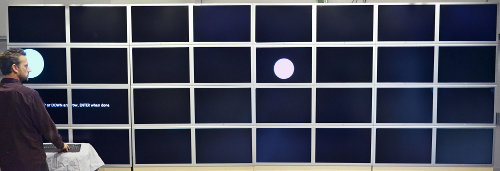Perception of Visual Variables on Tiled Wall-Sized Displays
Researchers
Summary
We ran two user studies on the perception of visual variables on tiled high-resolution wall-sized displays. These studies contribute an understanding of and indicators predicting how large variations in viewing distances and viewing angles affect the accurate perception of angles, area, and length. Our work, thus, helps visualization researchers with design considerations on how to create effective visualizations for these spaces. The first study showed that perception accuracy was impacted most when viewers were close to the wall but differently for each variable (Angle, Area, Length). Our second study examined the effect of perception when participants could move freely compared to when they had a static viewpoint. We found that a far but static viewpoint was as accurate but less time consuming than one that included free motion. Based on our findings, we recommend encouraging viewers to stand further back from the display when conducting perception estimation tasks. If tasks need to be conducted close to the wall display, important information should be placed directly in front of the viewer or above, and viewers should be provided with an estimation of the distortion effects predicted by our work—or encouraged to physically navigate the wall in specific ways to reduce judgement error
Pictures
This image shows one participant performing one trial in front of our wall-sized display
A motivating usage scenario in which the comparison of visual variables will be important - in particular when discussing with others.

